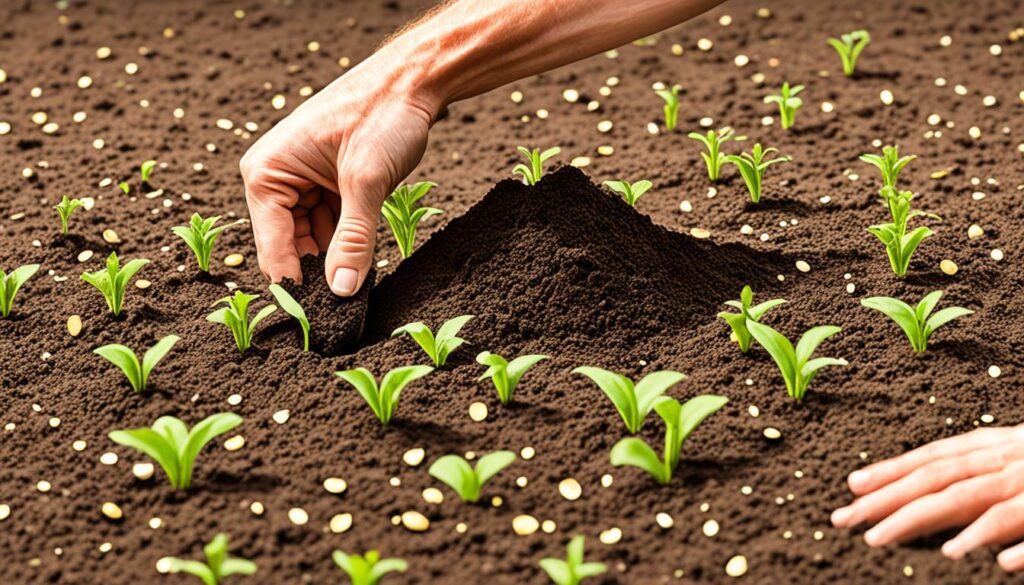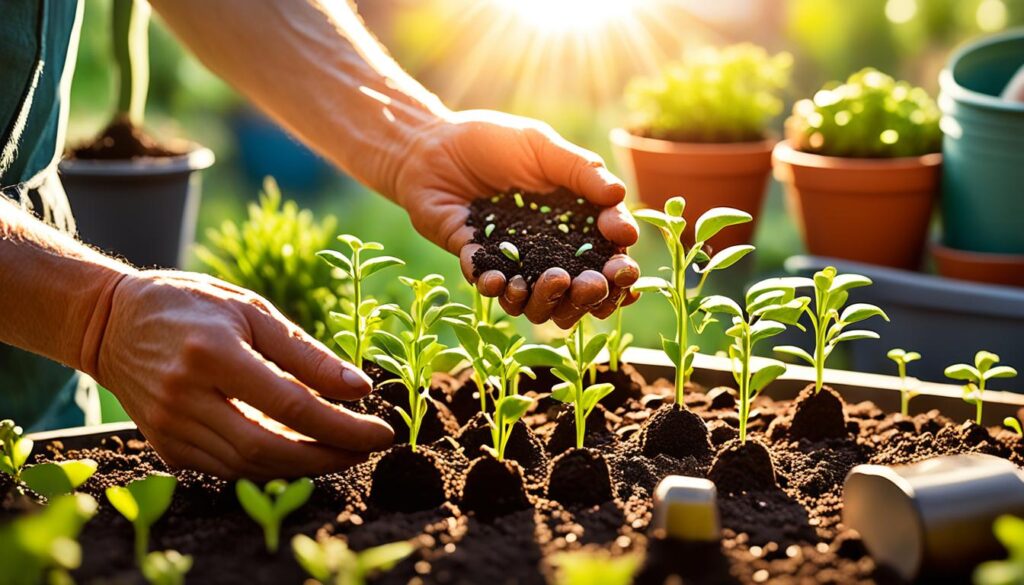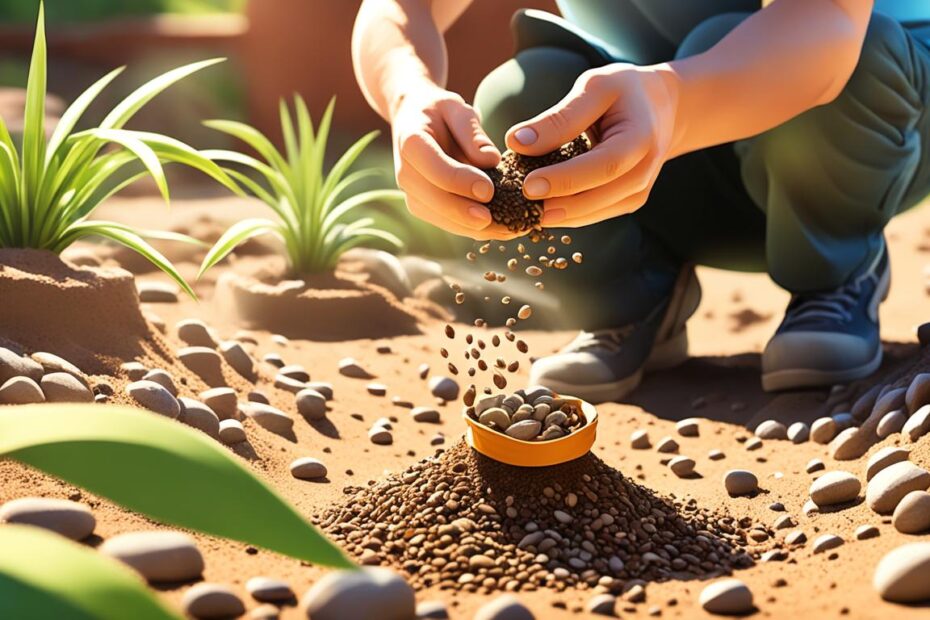Are you tired of the hassle of starting seeds indoors and transplanting them to your garden? What if there was a simpler, more cost-effective way to add plants to your garden? Well, look no further. Directly sowing seeds into the soil is the answer you’ve been searching for!
Contrary to popular belief, direct sowing can be just as successful as starting seeds indoors. In fact, it eliminates the need for special equipment and the tedious process of transplanting. But is it suitable for all plants? Can you really save money and grow a wide variety of plants directly in your garden? Let’s dive deeper and find out!
Key Takeaways:
- Direct sowing is a cost-effective way to add plants to your garden.
- Not all plants are suitable for direct sowing, so it’s important to research the specific plant species.
- Timing and soil preparation are crucial for successful direct sowing.
- Proper planting techniques and care are essential for the health and growth of direct-sown seeds.
- Choosing the right location and providing optimal growing conditions can increase the success of direct sowing.
When to Plant Seeds and Soil Preparation
Timing is crucial when it comes to planting seeds directly into the soil. The ideal time for seed planting varies depending on the plant species and the climate of your region.
For most vegetable seeds, the spring season is the perfect time for planting. Once the frost is out of the ground and the soil can be worked, you can start sowing your seeds. However, some seeds require warmer soil temperatures for successful germination. Therefore, it is essential to research the specific plant species and understand their preferred planting time.
Aside from timing, soil preparation is also vital for successful seed planting. Each plant species has specific preferences when it comes to the type of soil they thrive in, as well as the amount of sunlight, water, and care they require. Researching these preferences and making necessary soil amendments can create optimal growing conditions for your seeds.
“To plant a garden is to believe in tomorrow.” – Audrey Hepburn
Creating a beautiful and thriving garden starts with knowing when to plant your seeds and preparing the soil for their growth. By understanding the specific requirements of different plant species and taking the necessary steps to provide them with optimal conditions, you’ll set the stage for a successful gardening journey.
Soil Preparation Tips
- Conduct a soil test to determine its composition and pH level. This will help you identify any deficiencies or imbalances that need to be addressed.
- Remove any weeds, rocks, or debris from the planting area to ensure a clean and tidy environment for your seeds.
- Loosen the soil using a garden fork or tiller to improve its structure and allow for proper root development.
- Add organic matter such as compost or well-rotted manure to enrich the soil with essential nutrients and improve its water retention capacity.
- Follow the specific instructions on the seed packets regarding planting depth and spacing to ensure optimal growth.
Incorporating these soil preparation tips into your gardening routine will help create a fertile and nourishing environment for your seeds to thrive.
Best Planting Time for Common Vegetables
| Vegetable | Best Planting Time |
|---|---|
| Lettuce | Spring and fall |
| Tomatoes | Two weeks after the last frost date |
| Carrots | Early spring and late summer for fall harvest |
| Zucchini | After the last frost date |
| Peppers | Two weeks after the last frost date |
Planting Techniques for Direct Sowing
When it comes to direct sowing seeds, proper planting techniques are key to ensuring successful germination and growth. Here are some essential techniques to keep in mind:
1. Prepare the Soil: Before planting, it’s important to prepare the soil by removing any weeds, rocks, or clumps of dirt. This can be done by using a garden fork to loosen the soil and ensure a smoother planting surface. Adding organic matter, like compost, can also help improve the soil quality and provide essential nutrients for the growing seeds.
2. Seed Preparation: Some seeds may require special preparation before planting to enhance germination. This can include soaking the seeds in water or scarification, which involves nicking or scratching the seed coat to improve water absorption. Be sure to follow the instructions on the seed packet for any specific seed preparation recommendations.
3. Planting Depth and Spacing: When planting the seeds, it’s important to follow the recommended planting depth and spacing guidelines. In general, seeds should be planted about three times as deep as their diameter. Creating furrows or indents in the soil can help keep the seeds in place and make it easier to identify the planting locations.
4. Moisture Management: After planting, it’s crucial to keep the soil evenly moist to promote germination. Avoid overwatering, as this can lead to rotting, but also ensure that the soil doesn’t dry out completely. Regularly monitor the moisture levels and provide supplemental watering as needed.
“Proper planting techniques, including soil preparation and moisture management, are essential for successful direct sowing.”
By following these planting techniques, you can optimize the conditions for direct-sown seeds to thrive and grow into healthy plants.

| Advantages | Disadvantages |
|---|---|
| Cost-effective method | Not suitable for all plant species |
| Easier and simpler than starting seeds indoors | Requires proper timing for seed planting |
| Allows for a wider variety of plants to be grown | May require more care and maintenance |
Care and Maintenance of Direct Sown Seeds
Once your seeds have sprouted, it’s time to provide them with the care and attention they need to thrive. Taking proper care of your direct sown seeds will ensure their healthy growth and increase the chances of a successful harvest.
Protecting Your Seedlings
When your seedlings emerge, they are vulnerable to pests and harsh weather conditions. Protect them by using physical barriers such as cut pots or diatomaceous earth to ward off insects. Additionally, shade cloth can shield your seedlings from wilting during hot weather, ensuring that they receive the right amount of moisture and sunlight.

Thinning and Weeding
To ensure that your plants have enough space to grow and mature, thinning may be necessary. This involves removing excess seedlings to create proper spacing between plants. Regular weeding is also crucial to prevent competition for essential resources like water, sunlight, and nutrients. By keeping your garden bed free from weeds, you give your direct sown seeds the best chance to flourish.
Monitoring and Proper Identification
As your direct sown seeds continue to grow, it’s important to monitor their progress closely. This includes being able to distinguish between your seedlings and any unwanted weeds that might sprout up. Proper identification will help you avoid accidentally removing or disturbing your growing plants, ensuring their uninterrupted growth.
Fertilizing and Watering
Following the instructions on the seed packet for fertilizing and feeding is crucial for the optimal growth of your direct sown seeds. Overfertilizing can harm your plants, so it’s important to follow the recommended guidelines. Similarly, striking the right balance with watering is essential. Avoid overwatering, which can lead to root rot, and underwatering, which can cause wilting and stunted growth. Regularly check the soil moisture levels and adjust your watering accordingly to keep your seedlings healthy.
Summary
In this section, we’ve covered the essential care and maintenance steps for your direct sown seeds. Protecting your seedlings, thinning and weeding, monitoring and proper identification, and fertilizing and watering are crucial aspects of their care. By following these guidelines, you’ll create the optimal conditions for your direct sown seeds to thrive and produce an abundant harvest.
Tips for Successful Direct Sowing
Direct sowing is a fantastic way to grow plants directly in your garden, but there are a few key tips to keep in mind to ensure successful results. Here are some valuable insights to help you maximize your direct sowing efforts:
- Choose the Right Location: Select a garden spot that receives full sun and has well-draining soil. This will provide the optimal conditions for your seeds to germinate and grow.
- Thoroughly Water the Bed: Before planting your seeds, make sure to water the bed thoroughly. This will ensure even distribution of moisture, helping the seeds to sprout and establish properly.
- Use Shade Cloth: In hot and dry climates, using shade cloth can be beneficial to prevent the soil from drying out too quickly. This will help maintain the necessary moisture levels for successful germination.
- Create a Fine Soil Surface: Sift the soil to create a fine and smooth surface before planting your seeds. This will make it easier for the seeds to sprout and emerge through the soil.
- Add Organic Matter: To avoid the formation of a crust on the soil surface, adding organic matter like compost or aged manure is crucial. This will improve soil structure, promote better drainage, and enhance seed germination.
- Label and Identify: It’s essential to label the garden bed and accurately identify the seedlings as they emerge. This will prevent accidental disturbance or removal, ensuring the successful growth of your direct-sown plants.
- Use Fresh Seeds: Storing and using fresh seeds can significantly increase germination rates and overall success. Make sure to purchase seeds from reputable sources and store them properly for the best results.
By following these valuable tips, you’ll be well on your way to a successful direct sowing adventure. Let nature do its magic as you witness your seeds grow into beautiful plants, right in the comfort of your own garden.
Conclusion
Directly sowing seeds into the soil is a cost-effective and straightforward approach to growing a diverse range of plants in your garden. By employing proper planting techniques and providing attentive care to the seedlings, you can achieve success in your gardening endeavors. Timing your plantings, preparing the soil adequately, and ensuring optimal growing conditions are essential factors for successful direct sowing. With the right knowledge and dedication, direct sowing can reward you with a bountiful garden filled with thriving and healthy plants.
When choosing direct sowing over starting seeds indoors, you eliminate the need for specialized equipment or the hassle of transplanting. This method not only saves you money but also enables you to cultivate a wide variety of plants, giving your garden a diverse and vibrant collection.
Remember to research the specific requirements of each plant species, such as the ideal planting time, soil type, sunlight, water, and care. Removing weeds, rocks, and clumps of dirt from the soil, preparing the soil with organic matter, and following the instructions on the seed packets regarding planting depth and spacing are all vital steps for successful direct sowing.
By implementing these direct sowing tips, you can create an optimal environment for your seedlings to thrive. Choose a sunny location in your garden with well-draining soil, water the bed thoroughly before planting, and protect the soil from drying out too quickly. Additionally, labeling the garden bed and correctly identifying the seedlings will prevent unnecessary disturbance or removal. Using fresh seeds and following proper fertilization and feeding practices will further enhance the germination rates and overall success of your direct sowing endeavors.
FAQ
What is direct sowing?
Direct sowing is the process of planting seeds directly into the soil without starting them indoors or using transplanting methods.
Which plants are suitable for direct sowing?
Not all plants are suitable for direct sowing. Some plants require a longer growing season or specific germination conditions. It’s important to research the specific plant species to determine if direct sowing is suitable.
When is the best time to plant seeds directly into the soil?
The timing of seed planting depends on the plant species and the climate in your region. Most vegetable seeds can be planted in the spring as soon as the frost is out of the ground and the soil can be worked.
How do I prepare the soil for direct sowing?
To prepare the soil for direct sowing, remove weeds, rocks, and clumps of dirt. Loosen the soil with a garden fork and add organic matter like compost to improve the soil quality.
How deep should I plant the seeds?
The planting depth of seeds depends on the specific plant species. In general, seeds should be planted three times as deep as their diameter.
How do I protect the seedlings from pests?
To protect seedlings from pests, you can use physical barriers like cut pots or diatomaceous earth. These barriers can help keep insects away from the seedlings.
What should I do to ensure proper spacing for the plants to mature?
Thinning may be necessary to ensure proper spacing for the plants to mature. It’s important to monitor the progress of the seedlings and remove any excess plants.
How should I care for the seedlings after they have sprouted?
After the seeds have sprouted, it’s important to provide sun protection if needed and to regularly weed the area to prevent competition for water, sunlight, and nutrients. Follow the instructions on the seed packet for fertilizing and feeding the seedlings.
What are some tips for successful direct sowing?
To increase the success of direct sowing, choose a location in the garden that receives full sun and has well-draining soil. Water the bed thoroughly before planting and use shade cloth to prevent the soil from drying out too quickly. Label the garden bed to identify the seedlings and store and use fresh seeds for higher germination rates.
